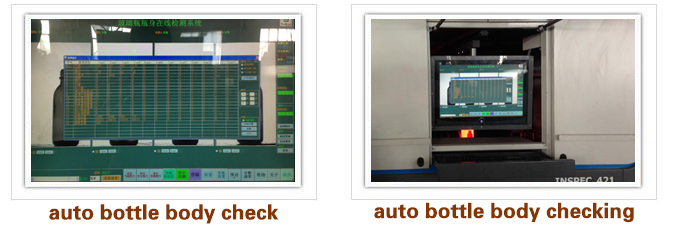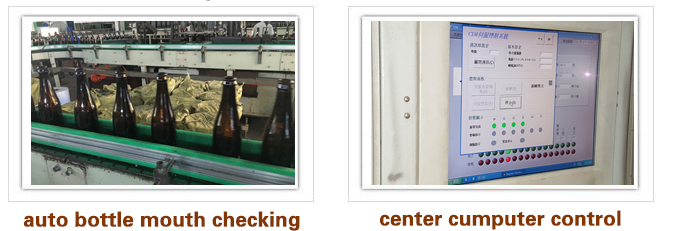

4.1 Products must be manufactured in accordance with drawings and technical documents that have been approved by the prescribed procedures and meet the standard.
4.2 Specifications
4.2.1 Full-container capacity tolerance should meet the requirements in table 1.
Table 1. Full-container Capacity Tolerance
Capacity(Nominal Value or Full-container)L, ml | Tolerance ml |
25<L≦50 | ±3 |
50<L≦100 | ±4 |
100<L≦200 | ±8 |
200<L≦300 | ±10 |
300<L≦500 | ±12 |
500<L≦750 | ±15 |
L>750 | ±25 |
Note: Tolerances for special products can be determined in accordance with clients’ requirements. | |
4.2.2 Height tolerance TH(mm) is calculated in Formula(1).
TH=±(0.6+0.004H) ………………………………(1)
In the formula:
H——bottle height,mm。
4.2.3 Body OD Tolerance TD(mm) is calculated in formula (2).
TD=(0.5+0.012D) ………………………………(2)
In the formula:
D——outer diameter,mm。
4.2.4 Vertical axis deviation TV(mm) is calculated in formula (3)、(4).
When H≦120mm
TV≦1.5 ………………………………(3)
When H>120mm
TV≦(0.5+0.01H) ………………………………(4)
In the formula:
H——bottle height,mm。
4.2.5 Bottle mouth OD tolerance should meet the requirements in table 2.
Table 2 Bottle Mouth OD Tolerance
Bottle Mouth OD D,mm | Tolerance,mm |
20<D≦60 | ±0.35 |
60<D≦80 | ±0.45 |
80<D≦100 | ±0.6 |
Note: Tolerances for special products can be determined in accordance with clients’ requirements. | |
4.2.6 Screw thread OD tolerance is the same as bottle mouth OD.
4.2.7 Bottle mouth ID
4.2.7.1 Mouth ID tolerance for bottles with an inner stopper should meet the requirements in table 2.
4.2.7.2 For bottles without an inner stopper the tolerance is ±1mm.
4.2.8 Tolerance of bottle head height(which should meet the requirements of drawings and technical documents)is ±0.3mm。
4.2.9 Bottle Body Thickness
For bottles that need not to be sprayed, the bottle body thickness≧1.5mm (irregular shaped bottles refer to drawings and technical documents): for bottles applied with cold or hot end coating, the body thickness≧1.2mm. Tolerances for special products can be determined in accordance with clients’ requirements.
4.2.10 Bottle Bottom Thickness
For those whose full-container capacities are below 150ml (including 150ml) it should be more than 2mm; for those above 150ml (excluding 150ml) it should be more than 3mm. Tolerances for special products can be determined in accordance with clients’ requirements.
4.2.11 Thickness proportion of one bottle should be less than 2:1
4.3 Appearance Quality
Bottle appearance quality need to meet requirements in table 3.
Table 3 Appearance Quality
Item Name | Index | |||
Mouth Flatness,mm | Mouth OD mm | ≦60 | ≦0.4 | |
≦90 | ≦0.6 | |||
>90 | ≦0.8 | |||
|
| ≦60 | ≦0.6 | |
≦90 | ≦0.8 | |||
>90 | ≦1 | |||
Body Joviality,mm | ≦(0.5+0.01)×2 In the formula:D——body diameter,mm | |||
Mouth Defects | Mouth Spikes | Not allowed | ||
Defects on the sealing surface that affect the sealing performance | Not allowed | |||
Mouth screw defects | Not allowed | |||
Apparent defects on mouth convex ring | Not allowed | |||
The mouth concaves in and is without an inner stopper | Allowed | |||
The mouth concaves in in a degree that affects the sealing performance | Not allowed | |||
Stoned | Diameter more than 1.5mm | Not allowed | ||
Diameter between 0.3mm~1.5mm, no cracks around, not more than | 2 | |||
Diameter below 0.3mm, visible every square centimeter not more than | 5 | |||
On the bottle mouth | Not allowed | |||
Crack | Refractive | Not allowed | ||
Slight crack on the sealing surface(demanded by vacuum leakproofness) | Not allowed | |||
Slight crack on the sealing surface( not demanded by vacuum leakproofness) | Allowed | |||
Bubble | Diameter more than 5mm | Not allowed | ||
Diameter between 2mm and 5mm, not more than | 2 | |||
Diameter between 1mm and 2mm, not more than | 3 | |||
Diameter between 0.3mm and 1mm, visible every square centimeter, not more than | 5 | |||
Diameter below 0.3mm | Unlimited | |||
Cracked bubbles、surface thin bubbles | Not allowed | |||
Bubbles on sealing surface | Not allowed | |||
Table 3 (to Continue)
Item Name | Index | |
Body Surface | Spikes on joint seam | Not allowed |
Joint seam sticks out (mm), not more than | 0.5 | |
Blank mold seam, finished mold seam (mm),not more than | 0.3 | |
Baffle mark, deep-set | Not allowed | |
Seriously apparent wrinkles, stripes, cold mould marks | Not allowed | |
The baffle mark clearly exceed the body part above the mold joint seam | Not allowed | |
Exterior wall roughened by black dots, oil spots and dirty mould | Not allowed | |
Imperfections that seriously damage the appearance | Not allowed | |
That the mark is obviously unclear | Not allowed | |
Inner Wall Defects | Sticky materials and spun glass on inner wall | Not allowed |
Inner wall of bottle neck obviously convexes | Not allowed | |
Deformation | Various obvious deformations, fat, convex or concave body, convex bottom, bottle head dislocated or tilted, bottom sinks, etc. | Not allowed |
4.4 The physical and chemical properties should meet requirements in table 4.
Table 4 Physical and Chemical Properties
Item Name | Index | |
Internal Pressure Resistance,MPa | Inflation bottle no less than | 1.2 |
Non-inflation bottle no less than | 0.5 | |
Thermal Shock Resistance(rapid temperature change when heated or coldened),℃ | Sterilization under normal temperature | ≧35 |
Sterilization under high temperature | ≧42 | |
Internal Stress, Level | Actual stress≦4 | |
Water Erosion Resistance Performance, Level | ≦HC3 | |
5 Test Method
5. 1 Specification
5.1.1 Capacity
Use a weighing apparatus whose sensitivity is 1g to weigh empty bottles. Then pour in water of indoor temperature and weigh again. Minus the former from the latter value and convert the unit to ml (1g weight of water is close to 1ml).
5.1.2 Sizes
5.1.2.1 Body OD
Measure the middle part of body with a slide caliper through any angles of the same level (quantitative detection), then calculate the body OD by averaging the max. and min. value.
5.1.2.2 Bottle Height
Measure with a height gage (quantitative detection) or with a limit gauge (qualitative detection).
5.1.2.3 Bottle head height (top of mouth), measure with a height gauge or slide caliper.
5.1.2.4 Mouth OD(Screw OD)
Measure with a slide caliper (quantitative detection) or with a limit gauge (qualitative detection).
5.1.2.5 Mouth (Neck) ID
Measure with a special inserting gauge or caliper. The insertion depth of bottle ID gauge should be no less than the length of inner stopper or the insertion depth of filling tube.
5.1.2.6 Thickness of The Wall and Bottom
Measure with thickness gauge or cut the bottle in two and measure with slide caliper.
5.1.2.7 Bottom Thickness Proportion of One Bottle
Use a measuring apparatus to find the proportion of the thickest and the thinnest parts of one bottle bottom.
5.1.2.8 Deviation of Vertical Axis
In accordance with GB8452-1987.
5.2 Appearance Quality
5.2.1 Body Ovality
Measure with a slide caliper (quantitative detection) or with a limit gauge (qualitative detection).
5.2.2 Unevenness of Mouth Surface
Measure with a plug gauge (qualitative detection) or with a dial gauge (stationary detection).
5.2.3 Parallelism Measuring of Mouth and Bottom Surface
Measure with a height caliper; divide the minimum value from the maximum value and you’ll get the parallelism.
5.2.4 Other Appearance Items
Visually estimate, or use a 10× scale magnifying glass to measure if necessary.
5.3 Physical and Chemical Performance
5.3.1 Inner Pressure Resistance
In accordance with GB/T4546-1998
5.3.2 Thermal Shock Resistance
In accordance with GB/T4547-1991.
5.3.3 Internal Stress
In accordance with GB/T4545-1984
5.3.4 Water Erosion Resistance
In accordance with GB/T4548-1995.
6 Inspection Rules
6.1 Products have to be inspected and approved by the inspection department of the manufacturing factory before they are put into market with a Product Qualification Certificate.
6.2 Product inspection include factory inspection and type inspection.
6.3 Factory Inspection
6.3.1 Factory inspection items are 4.2,4.3.
6.3.2 Sampling Scheme: In accordance with GB2828-1987. Adopt common inspection level II and examine the sampled products in normal procedures. Inspection items and acceptable quality level (AQL) refer to table 5.
Table 5 Factory Inspection Items
Category | Inspection Item | Acceptable Quality Level(AQL) |
Specification | Capacity, height, thickness ratio, vertical axis deviation, bottle mouth OD, mouth ID | 2.5 |
Thickness, bottle neck | 4.0 | |
Appearance Quality | Unevenness of mouth surface, parallelism of mouth and bottom surface, body Ovality, mouth defects, cracks, inner wall defects, deformations |
2.5 |
Stoned, bubble, body surface | 6.5 |
6.3.3 Factory inspection rules are negotiable with clients.
6.4 Type Inspection
6.4.1 Type inspection items are all technical requirement items.
6.4.2 Generally speaking, type inspection should be conducted at least once a year. In the following conditions type inspection has to be conducted too.
a) Trial manufacturing evaluation of new or old products when they are transferred to be manufactured in a new factory;
b) When formally put into production, if any changes are implemented on structure, material or craftsmanship and may affect product performance;
c) Manufacturing of the product has been suspended for over 3 months whatever the reasons are and plan to be restored;
d) Result of factory inspection differs much from that of last type inspection;
e) When state quality supervision bureau suggests to do type inspection.
6.4.3 Sampling Scheme:In accordance with GB2829-1987. Adopt level I single sampling scheme. Inspection items and rejection quality level refer to table 6.
Table 6 Type Inspection Items
Category |
Item | Rejection Quality Level (RQL) | Array [Ac Rc] |
Specification | Capacity, height, thickness ratio, vertical axis deviation, bottle mouth OD, mouth ID | 40 | [1, 2] |
Thickness, bottle neck | 50 | [1, 2] | |
Appearance Quality | Unevenness of mouth surface, parallelism of mouth and bottom surface, body Ovality, mouth defects, cracks, inner wall defects, deformations | 40 | [1, 2] |
Stoned, bubble, body surface | 65 | [2, 3] | |
Physical and Chemical Performance | 40 | [1, 2] | |
7 Mark, Package, Transportation And Storage
7 . 1 Mark
7.1.1 Every unit of package has to be attached with a Qualified Product label, on which name of the manufacturing factory , the product name, amount, the inspector’s name( or code name) as well as production date should be indicated.
7.1.2 Product packages should contain the following marks:
a) Product name and logo;
b) Specifications
c) Amount;
d) Release date;
e) Name and address of the manufacturer;
f) Executive standard, record no.
7.1.3 Transport package should contain the following marks:
a) Contents included in 7.1.2;
b) Volume;
c) Quality;
d) Meet the requirements of GB191.
7.1.4 Special requirements can be put forward by clients.
7.2 Package
According to necessity, products can be packaged with bags, carton boxes, large baskets and pallets, as long as they are not easily damaged. Generally carton boxes or pallets are required for the sake of reducing damage or pollution.
7.3 Transportation
Avoid violent vibration when transporting the products and handle them with great care when unloading.
7.4 Storage
Kept away from rain, dust, insects and pollution. Make sure they’re leak-proof.